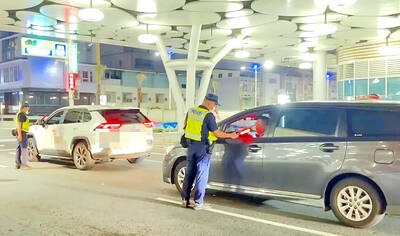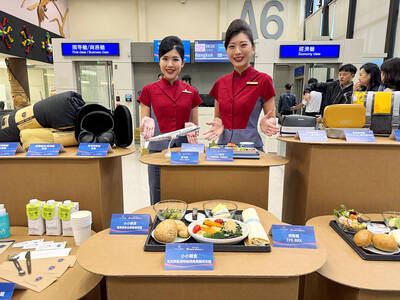Amid allegations that prominent electronics manufacturer Young Fast Optoelectronics had been using Chinese labor, opposition lawmakers yesterday urged the government to crack down on companies using Chinese labor in Taiwan under false pretenses.
Permits for Young Fast’s workers were reportedly issued after the company said that the workers would be in Taiwan for professional training.
Democratic Progressive Party (DPP) Legislator Wong Chin-chu (翁金珠) said the case could be the tip of the iceberg, adding that the government “owed the public an answer.”
“Just how many more cases of companies illegally using Chinese workers under the cover of -professional exchanges will we find?” she asked in the legislature, adding that they were “taking jobs” away from Taiwanese workers.
“After all, President Ma Ying-jeou (馬英九) said that he would definitely not allow workers from China to find jobs in Taiwan,” DPP Legislator Yeh Yi-jin (葉宜津) said, referring to an election pledge Ma made in 2008.
According to the latest statistics from the National Immigration Agency (NIA), the number of -professional exchanges from China has doubled since 2008. About 1,000 so-called professionals from China came to Taiwan in the first seven months of this year, compared with a total of 1,301 last year.
The Chinese-language Next Magazine reported yesterday that the practice was especially widespread among major electronics manufacturers that have a strong commercial presence in China. The magazine wrote that Kaohsiung-based Advanced Semiconductor Engineering had 366 Chinese workers visit Taiwan last year. Since 2008, 443 Chinese workers from AU Optronics also took part in the program.
While the Act Governing Relations Between the Peoples of the Taiwan Area and the Mainland Area (臺灣地區與大陸地區人民關係條例) forbids Chinese citizens from working in Taiwan, companies that fulfill certain criteria are allowed to apply in advance for teams of employees to visit Taiwan for professional development.
Visits are limited to four months per year and the participants are prohibited from engaging in “normal working behavior.”
Liao Wei-jen (廖為仁), the deputy director of the Bureau of Employment and Vocational Training at the Council of Labor Affairs, said violators would be fined between NT$200,000 (US$6,475) and NT$1 million and their Chinese workers would be deported.
He said the regulations meant the government “definitely has not opened up” to workers from China.
However, Chang Chi (張琪), deputy director-general at the NIA, the agency responsible for policing the program, admitted that spot checks were not conducted because of broad, and varying, definitions of what work entails. Instead, the NIA first conducts background checks on applicants. He added that the limited time Chinese workers were allowed to visit Taiwan along with the high cost of the program were “more than enough” to deter potential violations.

TRAFFIC SAFETY RULES: A positive result in a drug test would result in a two-year license suspension for the driver and vehicle, and a fine of up to NT$180,000 The Ministry of Transportation and Communications is to authorize police to conduct roadside saliva tests by the end of the year to deter people from driving while under the influence of narcotics, it said yesterday. The ministry last month unveiled a draft of amended regulations governing traffic safety rules and penalties, which included provisions empowering police to conduct mandatory saliva tests on drivers. While currently rules authorize police to use oral fluid testing kits for signs of drug use, they do not establish penalties for noncompliance or operating procedures for officers to follow, the ministry said. The proposed changes to the regulations require

The Executive Yuan yesterday announced that registration for a one-time universal NT$10,000 cash handout to help people in Taiwan survive US tariffs and inflation would start on Nov. 5, with payouts available as early as Nov. 12. Who is eligible for the handout? Registered Taiwanese nationals are eligible, including those born in Taiwan before April 30 next year with a birth certificate. Non-registered nationals with residence permits, foreign permanent residents and foreign spouses of Taiwanese citizens with residence permits also qualify for the handouts. For people who meet the eligibility requirements, but passed away between yesterday and April 30 next year, surviving family members

China Airlines Ltd (CAL) yesterday morning joined SkyTeam’s Aviation Challenge for the fourth time, operating a demonstration flight for “net zero carbon emissions” from Taiwan Taoyuan International Airport to Bangkok. The flight used sustainable aviation fuel (SAF) at a ratio of up to 40 percent, the highest proportion CAL has achieved to date, the nation’s largest carrier said. Since April, SAF has become available to Taiwanese international carriers at Taipei International Airport (Songshan airport), Kaohsiung International Airport and Taoyuan airport. In previous challenges, CAL operated “net zero carbon emission flights” to Singapore and Japan. At a ceremony at Taoyuan airport, China Airlines chief sustainability

‘ONE CHINA’: A statement that Berlin decides its own China policy did not seem to sit well with Beijing, which offered only one meeting with the German official German Minister for Foreign Affairs Johann Wadephul’s trip to China has been canceled, a spokesperson for his ministry said yesterday, amid rising tensions between the two nations, including over Taiwan. Wadephul had planned to address Chinese curbs on rare earths during his visit, but his comments about Berlin deciding on the “design” of its “one China” policy ahead of the trip appear to have rankled China. Asked about Wadephul’s comments, Chinese Ministry of Foreign Affairs spokesman Guo Jiakun (郭嘉昆) said the “one China principle” has “no room for any self-definition.” In the interview published on Thursday, Wadephul said he would urge China to